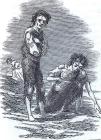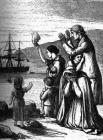3
Dr. Hutchison's health was never truly great after the attack in 1845 and he continued to suffer attacks that weakened his constitution up until he died.Frances Stewart comments on his continued ill health to an Aunt in a letter home in 1847 only three months before his death:
To Her Aunt Mrs Waller in Ireland
May 7 1847
" - poor Dr Hutchison has had another bad attack of apoplexy- I have not heard for some days- but his life hangs by a cobweb- Dr. Hay attends him-"
4
Sketch of Bridget O'Donnel and her Children, from the London Illustrated News22 December 1849
Ireland
 Credits:
Credits:London Illustrated News December 22 1849.
5
Between 1845 and 1852, Ireland experienced a period of great devastation, and its effects rippled out across Europe and the British Empire. In 1845 a disease affecting potatoes, called potato blight, destroyed crops across Europe; as a result of the potato shortage millions of people, especially in Scotland and Ireland, suffered from starvation and disease. One third of Ireland's population depended on potatoes as a primary food source. This event continues to be known as the Great Famine, and it contributed greatly to the large presence of Irish Diaspora in certain areas around the world. As a result of the famine, mass emigration out of Ireland occurred. About a million Irish died and another million emigrated to North America and Australia. Of the 100,000 Irish that sailed to Canada in 1847, one fifth died from disease and malnutrition. Many of them brought the disease to their new homes.Many communities across the British Empire endeavored to raise funds to aid in the relief of the problems plaguing Ireland and Scotland. Peterborough was one such community. Beginning in March, 1847, the town held public meetings and created committees to raise subscriptions for famine relief. Several leading citizens helped in raising £364 for Scotland which was forwarded by town treasurer James Wallis, Esq. Unfortunately, the House Committee that was in charge of collecting funds for Ireland never applied for their portion of the raised funds. It was decided in a public meeting in September,1847, that the funds set aside for Irish relief would be used to help the newly arriving Irish immigrants still suffering from the effects of the famine.
Of the immigrants who traveled from Ireland, many were suffered a malignant fever called typhus upon arrival in Peterborough. To deal with this situation a Health Committee was created consisting of Thomas Chambers, Charles Forest, Joseph Shaw, Robert Stenson and James Harvey, Esqs. They set up a temporary hospital on the Otonabee river on the southern edge of the town for those arriving in "destitute" conditions. Several doctors, including Dr. Hutchison and Dr. Burnham, were commissioned by the Emigration Department to tend to the sick. Many of the town's leading citizens cared for the sick at the "fever sheds", including Thomas A. Stewart.
6
Irish Potato Famine, Skibbereen, by Cork artist James Mahony (1810-1879)19th Century, Circa 1847
Cork, Ireland
 Credits:
Credits:Illustrated London News, 1847
7
Emigrants leave Ireland by Henry Doyle19th Century, 1868
Ireland
 Credits:
Credits:Illustration from Preface to the First Edition of an Illustrated History of Ireland from AD 400 to 1800 by Mary Frances Cusack, illustrated by Henry Doyle.
8
At least thirty-three Irish and several of the aid workers died in the fever sheds, including Thomas A. Stewart. Unfortunately, due to a weak constitution from previous illnesses, Dr. Hutchison succumbed to typhus himself. While his passing was noted by several newspapers, there seems to be some confusion as to which date he actually died. A small mention was even included in the 'Fifeshire Advertiser' in his hometown of Kirkcaldy Scotland.Obituary Notice in Peterborough Dispatch
"Died- Sunday July 1 1847 of typhus fever, caught while in attendance at the immigrant sheds, John Hutchison, Esq. M.D., aged 50 years. This melancholy event cast a gloom over the entire community, to whose interest he, both as a friend and physician has long been faithfully devoted."
From the Archives of Ontario: The Banner, Fri. Aug 20, 1847
"…in less than five days we believe from the first appearance such is rarely enjoyed by gentlemen of his profession. It is needless to add that the funeral of one so deep and universally regretted who numerously attended with every mark of profound and mournful respect. The shops of the town were all closed and all who were able to be present made a point of joining the melancholy procession to the graveyard and some of the funeral solemnities in accordance in the rights of the Scottish Church of which we believe Dr. Hutchison was a member were impressively performed at the dwelling house of the deceased by the Reverend Mr. Roger, after which the respected remains where consigned to the last home amid a large circle of sorrowing friends." Peterborough Gazette
9
Dr. Hutchison's Death Notice in the Fifeshire Advertiser2 October 1847
Kircaldy, Fife, Scotland
 Credits:
Credits:The Fifeshire Advertiser, Kircaldy District Council, Scotland
10
Obituary Fife-The local paper reported an obituary in the Peterborough Dispatch August 5, 1847:
"On Sunday the 1st instant, of Typhus Fever, caught while in attendance at the emigrant sheds, John Hutcheson Esq. MD, aged 50 years formerly of Kirkcaldy, in Fife, North Britain, and a resident in America since the year 1815. This melancholy event has cast a gloom over the entire community, to whose interest he, both as a friend and physician, has long been faithfully devoted. The writer trusts that some of his most intimate associates will pay a just and fitting tribute to the memory and merits of our departed friend as it would be both unbecoming and ungrateful that talent and worth such as Dr. Hutchison's should pass from the busy stage of life without something beyond a passing notice."
11
His illness and death was described in a letter by Frances Stewart to Mrs. Waller in August of 1847. Her husband Thomas would succumb to typhus two weeks later.To Mrs Waller Aug 9
" This has been a time of deep anxiety and alarm. The typhus fever and dysentery have reached even this remote place. Wherever those wretched immigrants came they brought with them sickness and death. Some of the members of the board of health have already fallen under its malignant influence, and also our dear, long-tried friend Dr. Hutchison. His illness was short, and from the first his life was despaired off. His constitution had been much injured from long exposure in the arduous discharge of his duties to the immigrants, and he had had an attack of apoplexy some time before which made the complaint more fatal and hopeless. His poor wife, who had little help, never left his bed-side; E. R-, was the only person who would venture to put the shroud on him. The panic was so great that neither man nor woman could be got to undertake this. Mrs. Hutchison and E- were left alone with the large young family; in this deeply trying time something had to be done without delay. E. R-, with a degree of resolution almost superhuman, threw the shroud over the body and put the arms into the sleeves. The funeral had to take place without delay. No bad results followed this painful task which these two loving friends had to fulfill for the dead."
12
Copy of the reciept of payment by the Board of Health of Peterborough to the estate of Dr. Hutchison11 April 1849
Peterborough, Ontario, Canada
 Credits:
Credits:Hutchison House Museum, Peterborough, Ontario, Canada
13
While some of his obituaries indicate that he passed away July 1st, 1847 it is more likely that Dr. Hutchison passed away August 1st, 1847. Martha was issued payment for his services at the fever sheds up to August 2nd, 1847. His current headstone also dictates that he died in Peterborough, Upper Canada. Aug 1, 1847 Aged 50.Dr. John Hutchison was buried in the burial ground in Peterborough when he died. A little over a year later, Sandford Fleming writes about visiting the gravesite and planting a willow tree in honor of his beloved cousin.
1848, Oct 11
: "… In the afternoon along with Hugh MacPhail planted a weeping willow over poor Dr. Hutchisons grave…."
This tree would have stood until many of the graves were moved to Little Lake Cemetery.
14
Section of the map of Peterborough, drawn by Sandford Fleming indicating the Burial Ground.2 June 1846
Peterborough, Ontario, Canada
 Credits:
Credits:Hutchison House Museum, Peterborough, Ontario, Canada
15
Gravesite of Dr. John Hutchison and his family19th Century, Circa 1871
Toronto, Ontario, Canada
 Credits:
Credits:Photo taken by Betty Hinton
Hutchison House Museum, Peterborough, Ontario, Canada
16
Dr. Hutchison's remains did not stay in Peterborough. After the death of his wife in 1871, John was moved to the Toronto Necropolis were he was reinterred with his wife and some of his children. Henry Hutchison (1834-1909), his wife, Emmeline Seaton (1842-1920), and their children, Bessie Hutchison (1884-1954), George Hutchison (1836-1905), Frances Mary Hutchison (1843-1863), James Hutchison (1829-1873) are all buried with the good Doctor. John's wife, Martha Holland (1806-1871) was also buried with the Hutchisons. In life, as in death, Dr. John Hutchison was surrounded by family.Dr. Hutchison rests among many of the notable residents of historic Upper Canada including William Lyon Mackenzie, Joseph Burr Tyrell, George Brown, several early Toronto Mayors and many other notable people. In 1850 The Necropolis opened in a poor area of Toronto known as Cabbagetown. It is more than 7 hectares of land which includes more than 900 transfers from Potters Field (the strangers' burial ground), executed criminals, politicians, rebels, journalists, former slaves and others who helped to shape Toronto and Upper Canada during the 19th century.